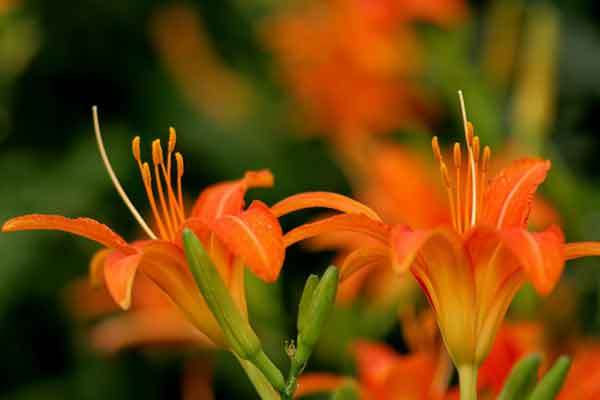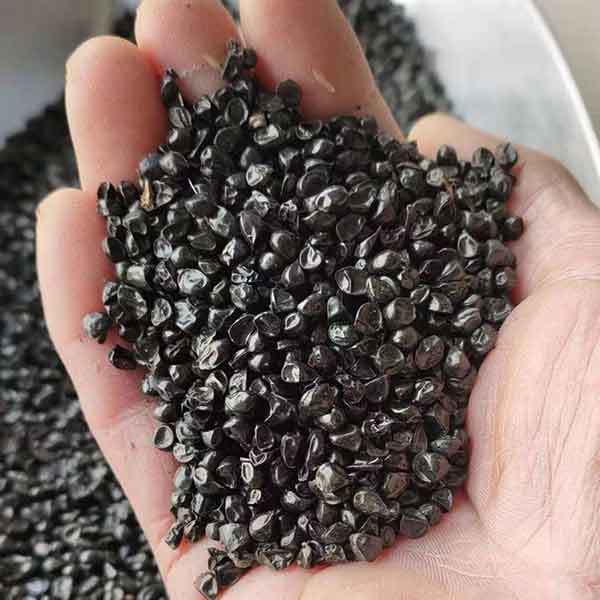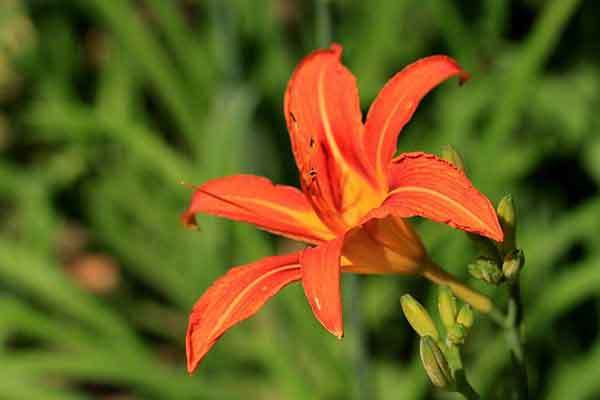How To Grow Daylilies From Seed - Wilson Garden
Can you grow daylilies from seed pods?
You can place daylily seed pods directly in nursery pots. There are two types of daylily seeds; one is a hard outer shell while the other is soft. When the seed pod begins to dry and open up, you should remove it from the parent plant. Be sure that there is no living flower in bloom on your parent plant yet before harvesting a pod of seeds.
Are daylilies hard to grow from seed?
Growing daylilies from seed is easy and you can sow day lilies seeds directly in the ground in most climates. They are open pollinated, so you do not need any sort of special germination medium to grow daylilies from seed. You should take the time to prepare the soil, plant your seeds correctly and keep them healthy.
Can I start daylilies indoors?
Daylilies are hardy perennials and not annuals. Growing daylilies in pots indoors and then transplant them to your garden in the spring. To do so, it’s important to select the best varieties for this practice, as well as using a potting mix that drains well and has adequate nutrients.
There are a couple of advantages to growing daylilies indoors. First, you grow in winter, which gives you a head start on spring outdoor planting. They also give you the chance to experiment with different varieties and colors prior to committing them to your landscape.
You can place daylily seeds into 1 gallon nursery pots, then fill it with half potting soil, half perlite or vermiculite. Water them gently and loosely cover them with plastic for 10-14 days until the new roots form. Transplant outdoors after the danger of frost has passed and nighttime temperatures above 40 degrees F.
Do daylily seeds need cold stratification?
Daylily seeds need cold stratification to break their dormancy and help to improve germination rates. Place the seeds in the refrigerator for 48 hours if you want to sow them in the fall or early spring. It will be advantageous to prepare the seed pods for germination.
This will help prevent any pathogens from entering the pod and infecting the seeds within. Once you have removed the daylilies seed pods from cold storage, allow them to dry naturally until they reach room temperature, or they can be incubated at warm temperatures of 40° F (4° C).
How to stratify daylily seeds?
Daylily seeds should be stratified before they are sown. Stratification mimics the natural process of winter. It involves placing seeds in prepared soil, then storing them at a specific refrigerator temperature for a period of time before planting.
Place them into the refrigerator before planting by mixing them with sand and vermiculite in bags or nursery trays. Stratify your daylily seeds for about six weeks and check on them each week. Then remove the frozen seed packets from the freezer. Store them in a cool, dry location until you are ready to sow them.
Do daylily seed need light to germinate?
No, daylilies don't require light to germinate. But it's very important to keep the pots soil warm throughout the germination process because daylilies seeds germinate well in a warm environment. They may come with instructions on how to germinate them when you buy daylily seeds from the store.

Do I need to soak daylily seeds before planting?
Yes, you will need to soak daylily seeds in water before planting them. If you’re growing daylilies from seed, it is best to soak the seeds before planting. This is to weaken the seed coat, helping it to break open so that the young plant can emerge easily once you have planted it into the ground.
You can place the seeds in a pot with water. Then, sit them for about 24 hours. Plant them immediately after the seeds have soaked. Planting daylily seeds once there has been no additional frost in your area and the soil temperature has warmed up to about 65 degrees Fahrenheit.
Do daylilies do well in clay soil?
Daylilies can thrive in clay soil. Clay soil is composed of small particles. It has a hard texture and this makes it difficult for plants to grow. Daylilies do well in clay soils as long as they are amply drained. Top dressing with compost annually will help to improve your clay soil.
All daylilies are clay-tolerant. A few high performance (reflected in their price) varieties may be more clay tolerant than others. Talk to your local nursery or garden center. You will know what varieties are best suited for your area.
Where is the best place to plant daylilies?
You should plant daylilies in well-drained soil and the areas also should receive six or more hours of full sun per day. Choose a 1.5 gallon pot with drainage holes in the bottom. You can use a light and sterile potting soil. It should contain perlite or vermiculite.
Daylilies are perennial flowering plants native to North America. They need protection if you live in a cold climate. Mulch around the plants with a layer of peat moss or shredded bark for water retention and protection from the elements.
Can I plant daylily seeds in the fall?
Daylily seeds will germinate in the fall or spring. You can water the seedlings. Place mulch around the base of each plant to protect against moisture loss. Continue to care for them through the winter months, they should bloom the following year. You should plant them in an area which is warm enough to grow new plants.
When should you plant daylily seeds?
Plant daylily seeds in the spring, as soon as the ground can be worked. You can start daylily seeds indoors 8 to 10 weeks before the last frost in spring, or sown directly into the garden once it is warm enough to plant them out (usually May).
Daylilies typically grow in USDA hardiness zones 3-10, but there are exceptions with some varieties being heat tolerant and being able to be grown outside of these zones. Grow daylily from seed by planting them in the garden after the last frost in spring, or in pots and then transplanting when they are at least 6 inches tall.
How deep do you plant daylilies?
Daylilies are a type of hardy, long-lasting perennial that you can propagate from seed. Plant the seeds 1/2 to 1 inch deep in your garden soil. Each seed is about 2 inches apart. To ensure their health and vigor, never plant them too deeply or they may rot at the root.
Make sure to choose a sunny location where the soil has been amended with compost and contains plenty of organic matter for good drainage and aeration. This will help daylilies seeds speed up germination. Tack care of daylilies includes proper watering and fertilizing, as well as pruning when needed.
How far apart should daylilies be spaced?
Plant daylilies seeds 4 to 6 inches apart in all directions. Daylilies grow well when they are spaced apart. This will help promote air circulation of roots and keep the daylilies plants healthy and also provide you with beautiful flowers.
How to grow daylilies from seed?
Daylilies are beautiful and colorful additions to your flower garden. If you yearn for an ever-changing flower garden, consider growing daylilies from seed. This perennial is easy to grow and produces brightly colored blooming flowers. How to plant daylily seeds?
Starting daylilies by seed is the simplest way. Like other plants, daylily plants start from seeds and grow into full-fledged plants. The trench should be 10 inches deep and three feet wide. Place daylily seeds 1/2 inch deep in the center of the trench. Cover them with about 1 inch of soil.
Water the seed bed thoroughly before covering with straw or pine bark mulch. Most varieties will take up to one to two weeks before they emerge from the soil. So be patient and water them regularly until they appear.

Do daylilies like sun or shade?
Most daylilies love full sun, but several varieties will tolerate partial shade. They will grow well in pots if provided drains well soil and has enough nutrients for them to absorb. These raised beds soil is well-drained and high in organic matter, so it isn't compact over time.
Should you water daylilies everyday?
Don't water daylilies too often. You can water them twice or thrice per week. They need water to help their roots retain a moist environment, so they can absorb nutrients through the soil more easily.
You should water daylilies when the soil is dry 1 inch below the surface. You can use rainwater or distilled water. You should water them every two days or even every day if you live in a hot and dry climate.
What's the best fertilizer for daylilies?
You need to fertilize daylilies to grow a healthy, beautiful display. The best fertilizer for daylilies is a product that provides a balanced blend of nitrogen, phosphorus, and potassium. The best organic fertilizer for your daylilies is manure.
Apply a liquid fertilizer such as fish emulsion as soon as the buds begin to open. The nutrients in liquid fish emulsion fertilizer will eventually leach into the soil, giving your plants a boost of essential nutrients that can last several weeks.
Daylilies require a fertilizer that has rapid-release nitrogen, phosphorus and potassium. The right method of fertilizing depends entirely on the type of your soil. Sandy soil is ideal. If your garden is clay soil, then the nutrients will not be leached away. You can reduce the amount of fertilizer used.
Are coffee grounds good for daylilies?
Yes, coffee grounds are good for daylilies. Coffee grounds provide a nutrient rich environment for your daylilies to thrive in. They are helpful in maintaining acidity in the soil, adding nutrients and loosening hard soil.
As the coffee grounds break down, they will supply nutrition to your plants while helping with moisture retention and drainage. Also, the antioxidants in coffee can help prevent insects which can stunt the growth of your plants.
How long does it take to grow daylilies from seed?
You can plant day lilies both in the ground and in plastic pots after the last frost in spring. Daylilies seeds will germinate within 2-3 weeks. The daylilies will be ready for their first blooming season after 6 months of growth.
Will daylilies bloom in the first year?
It depends on where you live because the temperature will affect when daylily blooms. If you live in a warmer area, your daylilies could bloom in their first year. Some varieties may need time to bloom. But most daylilies will bloom the following year after you plant them in the ground or container.
How many times a year do daylilies bloom?
Daylilies will return every year because they are perennials. Daylily bloom on average once a year. Some varieties will bloom twice in one season while others may bloom once every two years or even longer.
How many years do daylilies last?
Daylilies can last as long as three years with the right conditions. If you are propagating daylilies from seed, you need to choose a variety of daylilies that fit your climate.
Do daylilies spread on their own?
Daylilies are a perennial that can spread by sending out underground rhizomes. Rhizomes grow in a circular fashion around the mother plant and can produce new plants. New daylilies will begin to develop within two years of planting this perennial.
Can you plant 2 daylilies together?
They may tangle and become intertwined if you plant 2 daylilies too close together. This sometimes may force them to grow into each other's spot and will cause problems. It is possible to divide the daylilies clumps every 2 to 3 years. This will help them keep their size in check and maintain good form.
Where are the seeds on a daylily?
When the daylily blooms, it sets seed pods in the heart of the bloom. You will find daylily seeds in the seed pods at the end of the flower stem. The seed pods are 6 to 8 inch long and narrow at one end like an upside-down tear drop or a teardrop.
You can harvest daylily seeds from these seed pods. You need to pick the seed pods before their seeds ripen. So they do not fall off into the garden. Then, you should remove the daylily seeds from the pods and dry them before storing for future use.

What do daylily seeds look like?
Daylily seeds are black, like small beans. They range from 0.4cm to 0.75cm in diameter based on variety. Daylily have a hard outer shell that dries as the pod matures. The seed itself is divided into chambers and there is often a brownish hull around it starting to separate from the seed.
How to harvest daylily seeds?
Daylily seeds are easy to harvest. Daylilies produce seed pods that are filled with seeds. It looks like very thick, smooth bean pods. The seed pods appear in late summer and early fall. Pods may be harvested while they are still green and plump or hang them upside down to dry before threshing and separating out the seeds.
At the top of each pod there is a seam down the center. You can open the seam with your fingernail and extract the seeds inside. Store the daylily seeds in an airtight container after harvest.
How to store daylily seeds?
You should keep them in the fridge if you want to store them for a few years. Then, they do not rot or grow mold. Most people store daylily seeds in airtight glass containers, but mason jars work just as well.
Seal the crisper and label it with the type of daylily it contains, then put the bag in the freezer. If you’re storing them for long periods of time, try nesting the seeds between two pieces of wet blotter paper with a package of silica gel crystals nearby to absorb any moisture that accumulates within the package.
Can you freeze daylily seeds?
You should keep most daylilies seeds cool and dry. You can store daylily seeds for extended periods if taken care of properly. We do not recommend freezing daylily seeds as it may affect their germination rate.
Should you remove old blooms from daylilies?
Removing old blooms from daylilies is an optional process, but it helps to give the plant more of a natural look. This well encourages daylilies to send energy into developing new flowers, rather than into producing seeds.
If you are keeping these in a garden, then you probably don't have to worry about removing old blooms from your daylilies. You should remove dead blooms if you grow daylilies in a pot.
What do you do with daylilies at the end of the season?
Daylilies usually do not need pruning. But sometimes this may be helpful or necessary. It's also important to remove dead growth from daylily plants during the growing season because dead leaves could cause disease and attract pests. After cutting back Daylilies, you can expect more blooms next year.
How to winterize daylilies?
During winter, you need to keep the plant out of cold wind and rain. It is always best to bring your daylilies indoors before the first frost of the winter. Use a covered patio, or attach row cover or plastic mulch to prevent damage from any types of cold, wind and snow.
Should you mulch around daylilies?
Yes, you need to mulch daylilies with compost, leaf mulch, straw, wood chips and other materials. Mulch around daylilies will keep down weeds and help maintain moisture. This will save time and provide benefits throughout the growing season. The mulch should not touch the leaves if you mulch around the base of your plants.
What is the best mulch for daylilies?
Many flower beds are mulched with a layer of bark mulch, but it's not the best choice for daylilies. Mulch is applied to the soil surface around plants to help retain soil moisture and control weeds. A thick layer of straw can also control erosion if you are dealing with steep slopes or compacted soils.
You can use many materials as mulch. We highly recommend organic mulches. They break down into organic matter over time, while non-organic ones add chemicals to your soil. You can consider starting with leaf mulch, straw, pine needles or wood chips etc.
What critter eats daylilies?
Daylilies will attract a number of rodents, including squirrels, rats and voles. The bright purple flowers with orange centers attract these furry little plant munchers. Daylilies are the favorite treat of squirrels. Daylilies may be consumed by squirrels in late summer and fall, when the seeds are ripe.
If you have squirrel damage on your daylilies, you might consider planting them again in well-protected areas. To keep them away from your garden, places include netting or fencing around the daylilies. You can also use repellent solutions on your freshly planted plants, try the taste deterrents on both the soil and the plants themselves.
Will daylilies choke out other plants?
Daylilies do not generally choke out other plants in the middle of a lawn or garden. The reason daylily roots are invasive is that they grow very long and it looks unkempt when they reach the top of the soil without any shape to them.
You may need to remove daylilies before looking at them in disgust. Although some people may grow daylilies as groundcovers and spread them out in strategic locations with other plants, most homeowners know this is not what daylilies are intended for.



